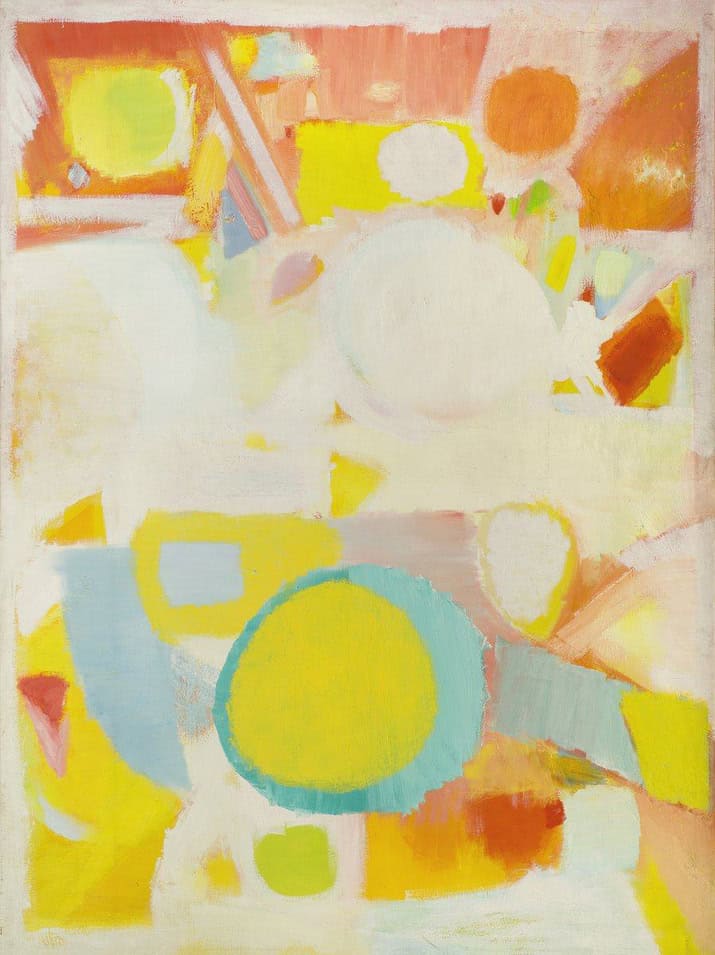
John Grillo
John Grillo Art For Sale
Click To Get A Valuation Of Your John Grillo Painting. You’ll get a confidential fair market valuation of your painting and its marketability. We pay cash for paintings by John Grillo and take consignments to the gallery.
This John Grillo painting is available.

John Grillo
Untitled (1963) - Available
Oil on Canvas, 72.5 x 54 inches
John Grillo Biography
John Grillo (1917 – 2014)
Both in his art and his life, John Grillo was a bit of a nomad. Unlike the majority of his contemporary arts who lived in a couple of cities, Grillo often changed location. Each change usually brought about a change of subject or style in his artwork. From the beginning, Grillo’s work used pure color with subtleties of fluid paint manipulation.
As a mature artist, John Grillo worked in more than six places before spending his final working years in Wellfleet, Massachusetts. He was born in a small town in this state but went to Connecticut in 1935 to study fine art at the Hartford Academy. During this time, Grilo was influenced by the Wadsworth Antheneum to make portraits his specialization. He also chose to depict scenes from the Depression showing the dispossessed and poor. The year 1939 saw Grillo paint a large mural of a family at dinner time with empty plates, having no food to eat. This content was reminiscent of Honoré Daumier.
After the U.S. became a part of World War II, John Grillo signed up to the Navy, and continued to draw and paint near Okinawa. He also spent time in Shanghai among Buddhist temples and Asian art. After the war, Grillo spent two years studying at the then California School of Fine Arts (San Francisco Art Institute). There, his style of abstract painting matured and flourished under the director Douglas MacAgy.
Grillo’s Teachers
Among many great teachers, Grillo took classes from Mark Rothko, David Park, Hassel Smith, Elmer Bischoff, and Clay Spohn. Spohn had spent some time in the 1920s with surrealists in Paris. Clay Spohn was important in the development of John Grillo’s artwork. In fact, Grillo said that Spohn was the most influential of his teachers.
Among the artists associated with abstract expressionism of the late 1940s, Grillo is often credited for being the most gestural at the CSFA. But, his work was based more in Surrealist automatism than his contemporaries. Breton described automatism as a technique like psychoanalytic free association. The idea being to relax the conscious mind’s control so the artist can express archetypical images from the subconscious. Other artists influenced by this were André Masson and Joan Miró.
For the two years that Grillo spent at the CSFA, the spontaneity of automatist emphasis continued. But, he also imbued it with ebullient color and lyricism. We can see this in the many gouaches and watercolor art he created on paper while there. John Grillo demonstrated that one can paint in the style of Abstract Expressionism without embracing its “confrontation with the canvas” ethos. To summarize, John Grillo’s paintings both took part and deviated from Bay Area Abstract Expressionism. In that he emphasized a lighter touch in comparison to his peers.
East Coast Move
John Grillo was not one to follow the crowd. When MacAgy was becoming more recognized around 1948, John Grillo moved to the East Coast. He intended to study with Hans Hofmann during the summers in Provincetown and New York. Grillo may have read or heard about Hofmann’s lectures ‘The Search for the Real,’ hence the move. Grillo and Hofmann had much in common. Particularly their thoughts of color modulation, pictorial structure and bold gestures.
Fifteen years before Grillo arrived on the East Coast, Hofmann worked at UC Berkeley and taught the likes of Erle Loran and Worth Ryder. In the mid-60s, it was Grillo’s turn to teach. He worked in the Department of Art Practice before moving to work at the University of Massachusetts in 1967. He taught there at Amherst until his retirement in 1991.
John Grillo Art
For most of his time at the University of Massachusetts, Grillo painted geometric configurations, in which you could pick out landscape elements. From 1973, his work took a leap towards figuration. This new work was also influenced by expressionism like Max Beckmann. For a short while, he worked in black and white too.
Grillo didn’t stay away from using color for long though. The early 80s saw Grillo bring color back in a dramatic way. He still focused on figures and circus performers but they became much less expressionist. In fact, they were more in tune with late modernist figures seen in France or by Picasso and Balthus. His late work with figures centered on the portrayal of women, with fuller figures, who were often a central focus in his multi-figure compositions. In these Grillo artworks, the women are “voluptuous”. This term, however, is not only useful in describing his subjects’ Rubenesque attributes, but also the palette he chose. The palette’s ebullient lushness came out of the abstractions Grillo painted before he turned towards figural paintings.
When he retired in 1991, John Grillo relocated to Wellfleet. This move saw his works gradually return to become more abstract. In fact, his later paintings were reminiscent of his preoccupations in the latter years of the 1940s. The later works still showed Grillo’s light tough and color generosity that became hallmarks of his work. John Grillo died at the age of 97.